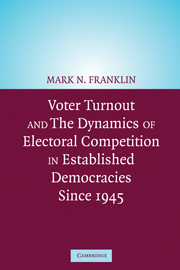Book contents
- Frontmatter
- Contents
- Figures
- Tables
- Preface
- The Authors
- Introduction
- 1 Confronting the Puzzles of Voter Turnout
- 2 A New Approach to the Calculus of Voting
- 3 The Role of Generational Replacement in Turnout Change
- 4 Rational Responses to Electoral Competition
- 5 Explaining Turnout Change in Twenty-Two Countries
- 6 The Character of Elections and the Individual Citizen
- 7 Understanding Turnout Decline
- 8 The Turnout Puzzles Revisited
- APPENDICES
- Bibliography
- Author Index
- Subject Index
6 - The Character of Elections and the Individual Citizen
Published online by Cambridge University Press: 08 February 2010
- Frontmatter
- Contents
- Figures
- Tables
- Preface
- The Authors
- Introduction
- 1 Confronting the Puzzles of Voter Turnout
- 2 A New Approach to the Calculus of Voting
- 3 The Role of Generational Replacement in Turnout Change
- 4 Rational Responses to Electoral Competition
- 5 Explaining Turnout Change in Twenty-Two Countries
- 6 The Character of Elections and the Individual Citizen
- 7 Understanding Turnout Decline
- 8 The Turnout Puzzles Revisited
- APPENDICES
- Bibliography
- Author Index
- Subject Index
Summary
So far in this book we have focused our analyses on electoral cohorts (in Chapter 3) or on electorates (Chapters 4 and 5) as units of analysis. Yet, in the end, individuals are the ones who make decisions to vote or not vote, so we need to complete the picture with analyses conducted at the individual level using survey data.
To be sure, survey data have been used before, in Chapter 3, as a source from which to derive the electoral cohorts that were the subject of that chapter. For that chapter, however, only two variables were taken from the individual-level data: date of birth and whether the individual voted or not. Already given the country in which the data were collected and the date of the election about which respondents had been questioned, these two additional pieces of information were all that was needed to construct the electoral cohorts that were studied in that chapter. The present chapter will be employing a larger number of individual-level variables to paint a more detailed picture of the individual citizen faced with an election.
The primary research question that we set out to address in this chapter is, “How do changes in the character of elections manifest themselves at the individual level?” We now know that more competitive elections (those that are likely to result in policy change) bring more citizens to the polls. But what is it that brings these citizens to the polls?
- Type
- Chapter
- Information
- Voter Turnout and the Dynamics of Electoral Competition in Established Democracies since 1945 , pp. 151 - 170Publisher: Cambridge University PressPrint publication year: 2004



